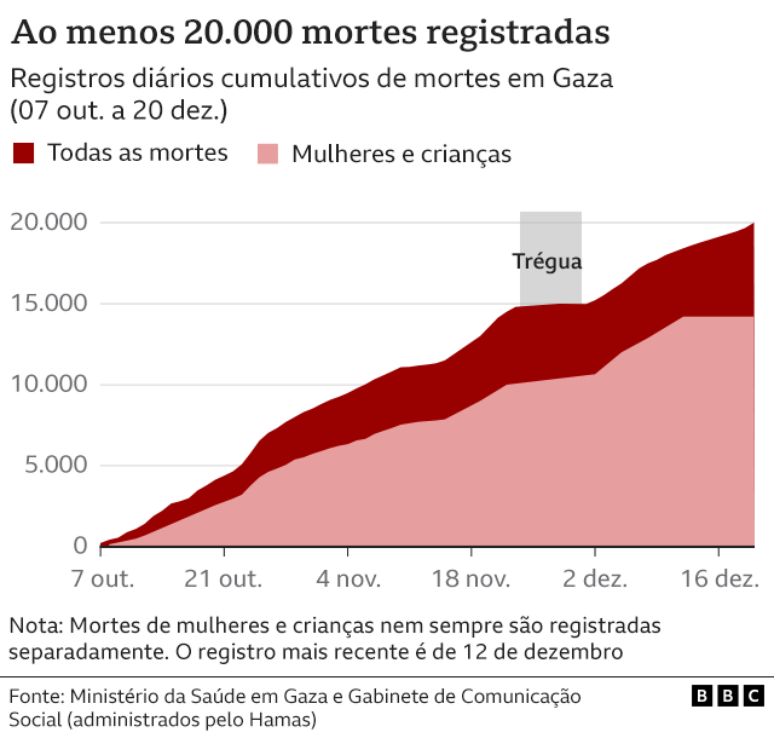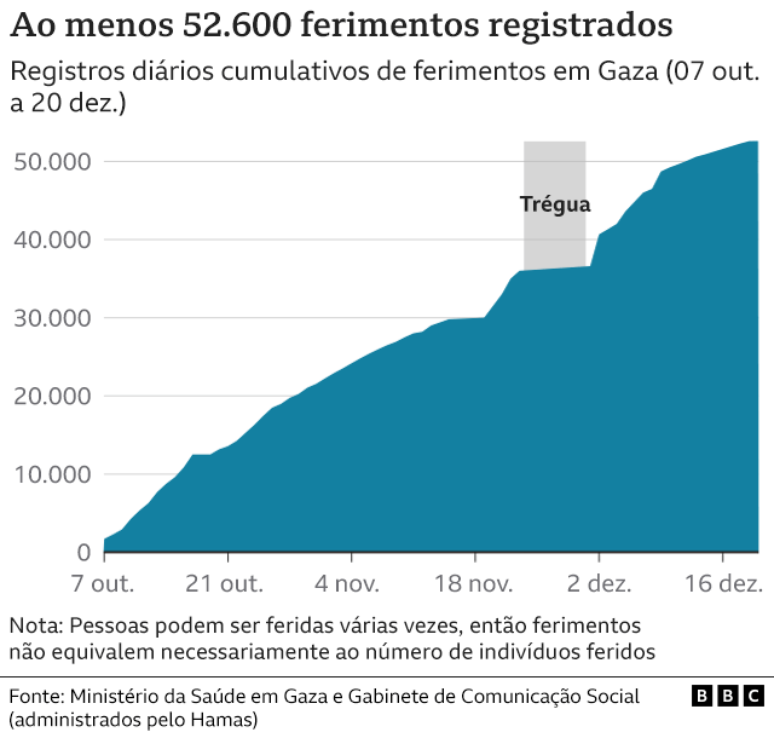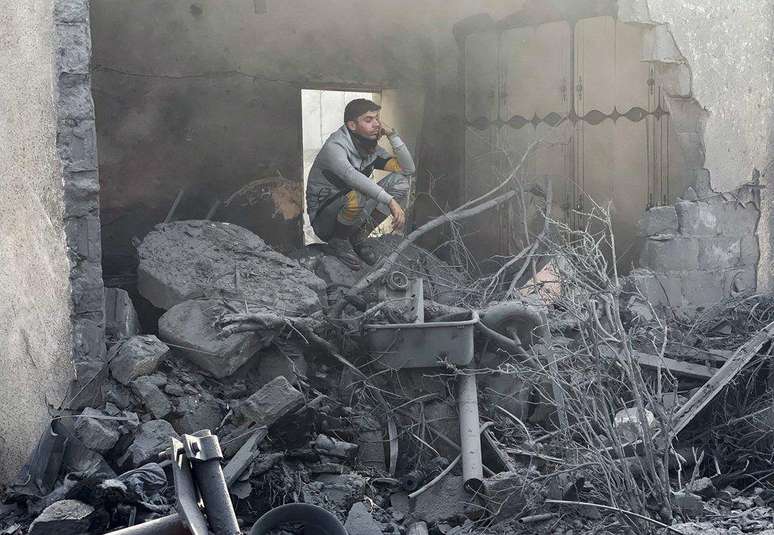The BBC takes a detailed look at the number of deaths and injuries and how it compares to other conflicts.
At least 20,000 people have been killed in Gaza since Israel began retaliating against Hamas attacks on October 7.
BBC Verify analyzes what the death toll in Gaza reveals about the conflict.
Health Ministry data in Hamas-run Gaza shows that on average nearly 300 people have been killed every day since the conflict began, not including the seven-day ceasefire. The World Health Organization’s (WHO) regional emergencies director, Richard Brennan, says he considers these numbers reliable.
Counting casualties is a challenge in any war zone, and doctors in Gaza say the death toll is likely higher than recorded, as it does not include bodies under the rubble of bombed buildings and those who were not taken to hospitals .
BBC Verify took a closer look at the numbers, how they compare to other conflicts and the impact on Gaza’s young population.
Large number of deaths
The mortality rate in this war was “exceptionally high”, says Professor Michael Spagat, who specializes in analyzing the number of victims in conflicts around the world, such as the 2003 Iraq war, the civil conflict in Colombia, the wars in the Democratic Republic of Congo, as well as previous conflicts between Israel and Gaza.
“Among the series of wars that have broken out in Gaza since 2008, the current one is unprecedented in both the number of people killed and indiscriminate killings,” Spagat says.

The number of 20,000 deaths represents almost 1% of Gaza’s 2.2 million inhabitants.
The BBC spoke to military experts who pointed out that the wide variety of bombs used by Israel – some weighing around 45kg and others up to 900kg – directly contributed to the large number of deaths in the conflict.
Being close to the impact of large bombs is like “surfing on Earth while a shock wave momentarily liquefies the ground,” explains Marc Garlasco, a former senior Pentagon intelligence analyst and former United Nations war crimes investigator who He spoke to victims and witnesses of these bombings.
What makes them even more devastating is that Gaza has a very high population density. The territory is only 41 km long and 10 km wide. On average, before the conflict, there were more than 5,700 people per km² in Gaza, a figure lower than the average for the city of Sao Paulo, but this figure rises to 9,000 in Gaza City.
Israel began its military campaign in Gaza after Hamas attacks, in which 1,200 people, most of them civilians, were killed. Three months later, the country is facing increasing pressure due to the number of civilian casualties in Gaza.
According to the research group Action on Armed Violence, in global conflicts between 2011 and 2021, when explosives were used in populated areas, on average 90% of victims were civilians.
According to US intelligence reports accessed by the American network CNN, from the beginning of the war until mid-December Israel dropped more than 29,000 bombs on Gaza, of which 40% to 45% were unguided.
These unguided bombs “can miss their target by up to 30 meters, which is the difference between hitting a Hamas headquarters and an apartment full of civilians,” explains Garlasco, who has worked on three previous conflicts in Gaza and is now an advisor to the Dutch. pacifist organization PAX.
The Israel Defense Forces (IDF) say they are taking precautionary measures to prevent harm to the civilian population.
According to the IDF, these measures include warnings before bombings, in cases where it is possible to do so. Israel also insists that the number of civilians killed in the conflict was better than in other international conflicts.
The IDF says it will “stop attacks when an unexpected civilian presence is seen.”
“We choose the right ammunition for each target so that no unnecessary damage is caused,” the Israeli military says.
Israel also claims that Hamas is using Gaza’s civilian population as a human shield.
How many civilians died?
According to the Hamas-led Ministry of Health, women and children account for around 70% of people killed in Gaza in the ongoing conflict.
However, Hamas numbers do not distinguish between male civilians and fighters.
An earlier analysis carried out by the Hamas government’s Social Communications Office and published on December 19 indicated that of the 19,667 deaths recorded so far, more than 8,000 were children and 6,200 were women.
The count also included among the victims 310 healthcare workers, 35 civil protection employees and 97 journalists, all civilians.
The war is having a particularly devastating impact on children in Gaza. Almost half of the area’s population is under 18, according to data released in 2022 by the Ministry of Health.
According to the ministry, more than 52,000 people have been injured in the conflict so far.
While there is no updated data on injured children, as of November 3, the figure stood at 8,067.

According to Unicef, the United Nations children’s agency, Gaza is now “the most dangerous place in the world to be a child.”
“Entire neighbourhoods, where children played and went to school, were transformed into lifeless piles of rubble,” says Adele Khodr, UNICEF regional director for the Middle East and North Africa.
How does the situation in Gaza compare to other conflicts?
Each conflict is unique in its characteristics, but experts interviewed by the BBC agree that the death rate in Gaza is significantly higher than in other recent conflicts.
“What we are seeing in terms of civilian deaths has already far exceeded the rate of any conflict we have documented,” says Emily Tripp, director of Airwars, an organization that has tracked civilian deaths in wars and conflicts since 2014.
Former Pentagon intelligence analyst Marc Garlasco says, “To find a similar density of explosives used in a small populated area, we may have to go back to the Vietnam War to find a comparable example, such as the Christmas bombings of 1972.” , when approximately 20,000 tons of bombs were dropped on Hanoi during Operation Linebacker II.”
An estimated 1,600 Vietnamese civilians were killed in this attack.
Already during the four-month offensive to expel the Islamic State from the Syrian city of Raqqa in 2017, the US-led coalition’s air and artillery strikes killed on average fewer than 20 civilians a day, according to Amnesty International.
It is not known exactly how many civilians lived there at the time, but UN officials estimate it was between 50,000 and 100,000. Additionally, more than 160,000 civilians have reportedly fled their homes and been displaced within the country.
And an Associated Press investigation suggested that between 9,000 and 11,000 civilians were killed in the nine-month battle for the Iraqi city of Mosul between U.S.-backed Iraqi forces and the Islamic State, a dispute that ended in 2017.
This equates to an average of fewer than 40 civilian deaths per day.
Mosul had an estimated population of less than 2 million people when the Islamic State captured the city in 2014.
During the nearly two-year war in Ukraine, the UN estimates that at least 10,000 civilians were killed.
However, the UN human rights monitoring mission warned that the real number could be significantly higher, given the hurdles and time involved in verification.
And comparing mortality rates across conflicts is difficult, in part because different methodologies are used to estimate deaths.

How many Hamas fighters were killed?
Israel has said its goal is to destroy Hamas, but it is unclear how many members of the Palestinian group have been killed.
The authorities have already spoken of “thousands”.
Hamas is considered a terrorist organization by the governments of Israel, the United Kingdom and some other countries.
But when asked directly, the Israeli military said “there is no exact number of Hamas terrorists killed.”
According to the AFP news agency, senior Israeli officials have suggested that Israel killed two Palestinian civilians for every Hamas fighter.
This ratio was called “tremendously positive” by military spokesman Jonathan Conricus.
The BBC has failed to establish a clear method of verifying the number of fighters killed.
Professor Michael Spagat says he “wouldn’t be surprised” if around 80% of those killed were civilians.
There are no “reliable numbers” on the ratio of civilians to fighters killed in Gaza, say Hamit Dardagan and John Sloboda of Iraq Body Count, an organization with experience counting and analyzing deaths in conflicts in Iraq.
*Becky Dale contributed to this report.
Source: Terra
Rose James is a Gossipify movie and series reviewer known for her in-depth analysis and unique perspective on the latest releases. With a background in film studies, she provides engaging and informative reviews, and keeps readers up to date with industry trends and emerging talents.






